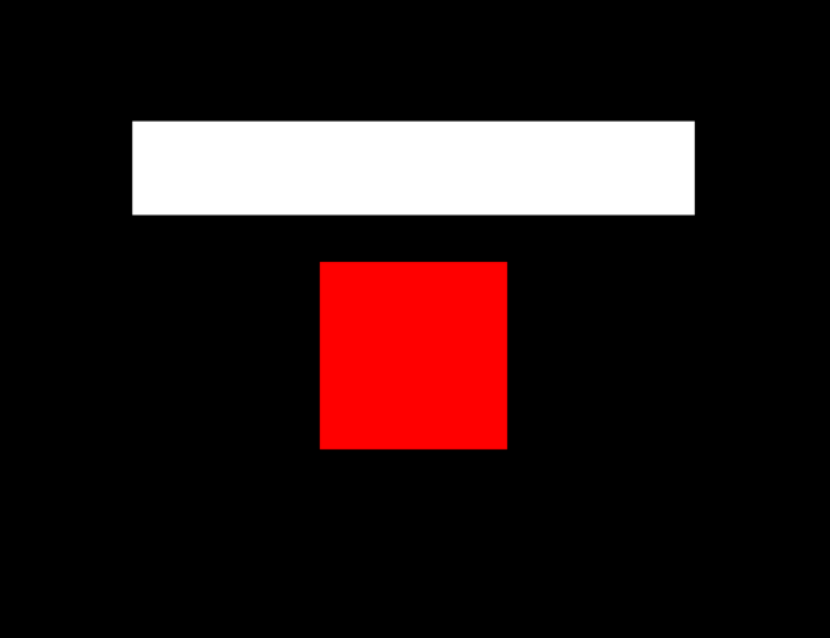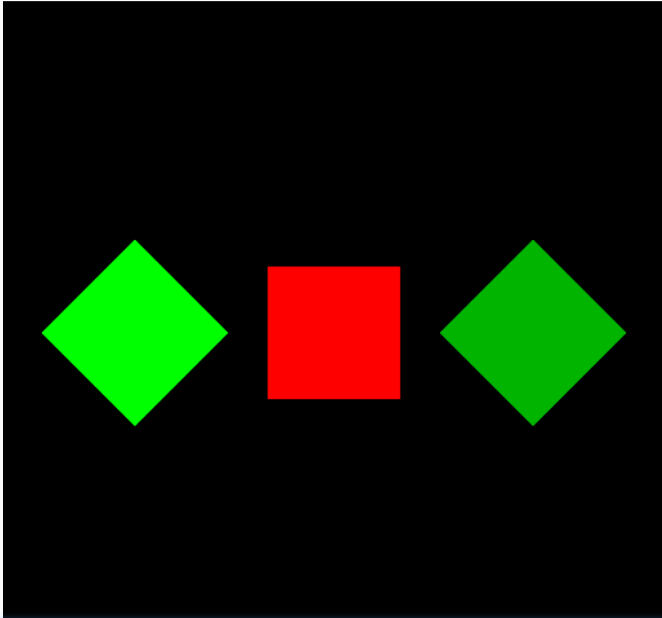实验一:
实验步骤:首先要进行背景颜色的设定和显示的范围和图形的绘制,画一个凸多边形可以调用glBegin(GL_POLYGON),后边用glVertex2f( , )指定顶点坐标,需要注意凸多边形的顶点指定需要按逆时针方向
然后在myDraw函数里面设置颜色 红色:glColor3f(1.0,0.0,0.0); 绿色:glColor3f(0.0,1.0,0.0);蓝色: glColor3f(0.0,1.0,0.0);
平移函数 :glTranslatef(0.0, 2.0, 0.0); //向Y方向平移俩个单位
缩放函数: glScalef(3.0, 0.5, 1.0);//X方向变为原来的3倍,y方向缩放为原来的0.5倍
然后设置颜色为白色,调用绘制函数即可
code:
// 提示:写完代码请保存之后再进行评测
#include <GL/freeglut.h>
#include<stdio.h>
// 评测代码所用头文件-开始
#include<opencv2/core/core.hpp>
#include<opencv2/highgui/highgui.hpp>
#include<opencv2/imgproc/imgproc.hpp>
// 评测代码所用头文件-结束
void init(void)
{
glClearColor(0.0, 0.0, 0.0, 0.0); //设置背景颜色
glMatrixMode(GL_PROJECTION);
gluOrtho2D(-5.0, 5.0, -5.0, 5.0); //设置显示的范围是X:-5.0~5.0, Y:-5.0~5.0
glMatrixMode(GL_MODELVIEW);
}
void drawSquare(void) //绘制中心在原点,边长为2的正方形
{
// 请在此添加你的代码
/********** Begin ********/
glBegin (GL_POLYGON);
//顶点指定需要按逆时针方向
glVertex2f (-1.0f,-1.0f); //左下点
glVertex2f (1.0f,-1.0f); //右下点
glVertex2f (1.0f, 1.0f); //右上点
glVertex2f (-1.0f,1.0f); //左上点
glEnd ( );
/********** End **********/
}
void myDraw(void) //二维几何变换
{
// 请在此添加你的代码
/********** Begin ********/
glColor3f(1.0,0.0,0.0);
drawSquare();
glColor3f(1.0,1.0,1.0);
glTranslatef(0.0, 2.0, 0.0);
glScalef(3.0, 0.5, 1.0);//缩放0.5倍,水平方向镜像
drawSquare();
/********** End **********/
glFlush();
}
int main(int argc, char *argv[])
{
GLubyte* pPixelData = (GLubyte*)malloc(400 * 400 * 3);//分配内存
GLint viewport[4] = {0};
glutInit(&argc, argv);
glutInitWindowPosition(100, 100);
glutInitWindowSize(400, 400);
glutCreateWindow("几何变换示例");
init();
glutDisplayFunc(&myDraw);
glutMainLoopEvent();
/*************以下为评测代码,与本次实验内容无关,请勿修改**************/
glReadBuffer(GL_FRONT);
glPixelStorei(GL_UNPACK_ALIGNMENT, 4);
glGetIntegerv(GL_VIEWPORT, viewport);
glReadPixels(viewport[0], viewport[1], viewport[2], viewport[3], GL_RGB, GL_UNSIGNED_BYTE, pPixelData);
cv::Mat img;
std::vector<cv::Mat> imgPlanes;
img.create(400, 400, CV_8UC3);
cv::split(img, imgPlanes);
for(int i = 0; i < 400; i ++) {
unsigned char* plane0Ptr = imgPlanes[0].ptr<unsigned char>(i);
unsigned char* plane1Ptr = imgPlanes[1].ptr<unsigned char>(i);
unsigned char* plane2Ptr = imgPlanes[2].ptr<unsigned char>(i);
for(int j = 0; j < 400; j ++) {
int k = 3 * (i * 400 + j);
plane2Ptr[j] = pPixelData[k];
plane1Ptr[j] = pPixelData[k+1];
plane0Ptr[j] = pPixelData[k+2];
}
}
cv::merge(imgPlanes, img);
cv::flip(img, img ,0);
cv::namedWindow("openglGrab");
cv::imshow("openglGrab", img);
//cv::waitKey();
cv::imwrite("../img_step1/test.jpg", img);
return 0;
}
实验结果:

实验二:
在实验一的基础上加上了旋转函数
glTranslatef(-3.0, 0.0, 0.0);//x方向左平移 3
glRotatef(45.0, 0.0, 0.0, 1.0);//逆时针旋转45度
此时画右边的图形的时候,需要先进行右平移6个单位
glTranslatef(6.0, 0.0, 0.0);
这里我们用glPushMatrix(); glPopMatrix();来保存原来的图形
下面时左移3,旋转45度
glPushMatrix();
glTranslatef(-3.0, 0.0, 0.0);
glRotatef(45.0, 0.0, 0.0, 1.0);
glColor3f(0.0, 1.0, 0.0);
drawSquare();
glPopMatrix();
下面是右移3 ,旋转45度
glPushMatrix();
glTranslatef(3.0, 0.0, 0.0);
glRotatef(45.0, 0.0, 0.0, 1.0);
glColor3f(0.0, 0.7, 0.0);
drawSquare();
glPopMatrix();
code:
// 提示:写完代码请保存之后再进行评测
#include <GL/freeglut.h>
#include<stdio.h>
// 评测代码所用头文件-开始
#include<opencv2/core/core.hpp>
#include<opencv2/highgui/highgui.hpp>
#include<opencv2/imgproc/imgproc.hpp>
// 评测代码所用头文件-结束
void init(void)
{
glClearColor(0.0, 0.0, 0.0, 0.0); //设置背景颜色
glMatrixMode(GL_PROJECTION);
gluOrtho2D(-5.0, 5.0, -5.0, 5.0); //设置显示的范围是X:-5.0~5.0, Y:-5.0~5.0
glMatrixMode(GL_MODELVIEW);
}
void drawSquare(void) //绘制中心在原点,边长为2的正方形
{
// 请在此添加你的代码
/********** Begin ********/
glBegin (GL_POLYGON);
//顶点指定需要按逆时针方向
glVertex2f (-1.0f,-1.0f); //左下点
glVertex2f (1.0f,-1.0f); //右下点
glVertex2f (1.0f, 1.0f); //右上点
glVertex2f (-1.0f,1.0f); //左上点
glEnd ( );
/********** End **********/
}
void myDraw(void) //二维几何变换
{
// 请在此添加你的代码
/********** Begin ********/
glClear(GL_COLOR_BUFFER_BIT);
glLoadIdentity();
glPushMatrix();
glColor3f(1.0, 0.0, 0.0);
drawSquare();
glPopMatrix();
glPushMatrix();
glTranslatef(-3.0, 0.0, 0.0);
glRotatef(45.0, 0.0, 0.0, 1.0);
glColor3f(0.0, 1.0, 0.0);
drawSquare();
glPopMatrix();
glPushMatrix();
glTranslatef(3.0, 0.0, 0.0);
glRotatef(45.0, 0.0, 0.0, 1.0);
glColor3f(0.0, 0.7, 0.0);
drawSquare();
glPopMatrix();
/********** End **********/
glFlush();
}
int main(int argc, char *argv[])
{
GLubyte* pPixelData = (GLubyte*)malloc(400 * 400 * 3);//分配内存
GLint viewport[4] = {0};
glutInit(&argc, argv);
glutInitWindowPosition(100, 100);
glutInitWindowSize(400, 400);
glutCreateWindow("几何变换示例");
init();
glutDisplayFunc(&myDraw);
glutMainLoopEvent();
/*************以下为评测代码,与本次实验内容无关,请勿修改**************/
glReadBuffer(GL_FRONT);
glPixelStorei(GL_UNPACK_ALIGNMENT, 4);
glGetIntegerv(GL_VIEWPORT, viewport);
glReadPixels(viewport[0], viewport[1], viewport[2], viewport[3], GL_RGB, GL_UNSIGNED_BYTE, pPixelData);
cv::Mat img;
std::vector<cv::Mat> imgPlanes;
img.create(400, 400, CV_8UC3);
cv::split(img, imgPlanes);
for(int i = 0; i < 400; i ++) {
unsigned char* plane0Ptr = imgPlanes[0].ptr<unsigned char>(i);
unsigned char* plane1Ptr = imgPlanes[1].ptr<unsigned char>(i);
unsigned char* plane2Ptr = imgPlanes[2].ptr<unsigned char>(i);
for(int j = 0; j < 400; j ++) {
int k = 3 * (i * 400 + j);
plane2Ptr[j] = pPixelData[k];
plane1Ptr[j] = pPixelData[k+1];
plane0Ptr[j] = pPixelData[k+2];
}
}
cv::merge(imgPlanes, img);
cv::flip(img, img ,0);
cv::namedWindow("openglGrab");
cv::imshow("openglGrab", img);
//cv::waitKey();
cv::imwrite("../img_step2/test.jpg", img);
return 0;
}
实验结果:

实验三:
没啥好说的就是先2俩个实验的结合
code;
// 提示:写完代码请保存之后再进行评测
#include <GL/freeglut.h>
#include<stdio.h>
// 评测代码所用头文件-开始
#include<opencv2/core/core.hpp>
#include<opencv2/highgui/highgui.hpp>
#include<opencv2/imgproc/imgproc.hpp>
// 评测代码所用头文件-结束
void init(void)
{
glClearColor(0.0, 0.0, 0.0, 0.0); //设置背景颜色
glMatrixMode(GL_PROJECTION);
gluOrtho2D(-5.0, 5.0, -5.0, 5.0); //设置显示的范围是X:-5.0~5.0, Y:-5.0~5.0
glMatrixMode(GL_MODELVIEW);
}
void drawSquare(void) //绘制中心在原点,边长为2的正方形
{
// 请在此添加你的代码
/********** Begin ********/
glBegin (GL_POLYGON);
//顶点指定需要按逆时针方向
glVertex2f (-1.0f,-1.0f); //左下点
glVertex2f (1.0f,-1.0f); //右下点
glVertex2f (1.0f, 1.0f); //右上点
glVertex2f (-1.0f,1.0f); //左上点
glEnd ( );
/********** End **********/
}
void myDraw(void) //二维几何变换
{
// 请在此添加你的代码
/********** Begin ********/
glPushMatrix();
glColor3f(1.0, 0.0, 0.0);
drawSquare();
glPopMatrix();
glPushMatrix();
glColor3f(1.0,1.0,1.0);
glTranslatef(0.0, 2.0, 0.0);
glScalef(3.0, 0.5, 1.0);//缩放0.5倍,水平方向镜像
drawSquare();
glPopMatrix();
glPushMatrix();
glColor3f(0.0,0.0,1.0);
glTranslatef(0.0, -3.0, 0.0);
glScalef(4.0, 1.5, 1.0);//缩放0.5倍,水平方向镜像
drawSquare();
glPopMatrix();
glPushMatrix();
glTranslatef(-3.0, 0.0, 0.0);
glPushMatrix();
glRotatef(45.0, 0.0, 0.0, 1.0);
glColor3f(0.0, 1.0, 0.0);
drawSquare();
glPopMatrix();
glTranslatef(6.0, 0.0, 0.0);
glPushMatrix();
glRotatef(45.0, 0.0, 0.0, 1.0);
glColor3f(0.0, 0.7, 0.0);
drawSquare();
glPopMatrix();
/********** End **********/
glFlush();
}
int main(int argc, char *argv[])
{
GLubyte* pPixelData = (GLubyte*)malloc(400 * 400 * 3);//分配内存
GLint viewport[4] = {0};
glutInit(&argc, argv);
glutInitWindowPosition(100, 100);
glutInitWindowSize(400, 400);
glutCreateWindow("几何变换示例");
init();
glutDisplayFunc(&myDraw);
glutMainLoopEvent();
/*************以下为评测代码,与本次实验内容无关,请勿修改**************/
glReadBuffer(GL_FRONT);
glPixelStorei(GL_UNPACK_ALIGNMENT, 4);
glGetIntegerv(GL_VIEWPORT, viewport);
glReadPixels(viewport[0], viewport[1], viewport[2], viewport[3], GL_RGB, GL_UNSIGNED_BYTE, pPixelData);
cv::Mat img;
std::vector<cv::Mat> imgPlanes;
img.create(400, 400, CV_8UC3);
cv::split(img, imgPlanes);
for(int i = 0; i < 400; i ++) {
unsigned char* plane0Ptr = imgPlanes[0].ptr<unsigned char>(i);
unsigned char* plane1Ptr = imgPlanes[1].ptr<unsigned char>(i);
unsigned char* plane2Ptr = imgPlanes[2].ptr<unsigned char>(i);
for(int j = 0; j < 400; j ++) {
int k = 3 * (i * 400 + j);
plane2Ptr[j] = pPixelData[k];
plane1Ptr[j] = pPixelData[k+1];
plane0Ptr[j] = pPixelData[k+2];
}
}
cv::merge(imgPlanes, img);
cv::flip(img, img ,0);
cv::namedWindow("openglGrab");
cv::imshow("openglGrab", img);
//cv::waitKey();
cv::imwrite("../img_step3/test.jpg", img);
return 0;
}
实验结果:

实验四
这里需要重新设置一下绘制函数drawDiamond
glBegin (GL_POLYGON);
//顶点指定需要按逆时针方向
glVertex2f (0.0f,0.0f); //左下点
glVertex2f (1.0f,2.0f); //右下点
glVertex2f (0.0f,4.0f); //右上点
glVertex2f (-1.0f,2.0f); //左上点
glEnd ( );// 注意这里的顶点的输入一定要是逆时针的
然后运用之前的旋转函数
glRotatef
code:
// 提示:写完代码请保存之后再进行评测
#include <GL/freeglut.h>
#include<stdio.h>
// 评测代码所用头文件-开始
#include<opencv2/core/core.hpp>
#include<opencv2/highgui/highgui.hpp>
#include<opencv2/imgproc/imgproc.hpp>
// 评测代码所用头文件-结束
void init(void)
{
glClearColor(0.0, 0.0, 0.0, 0.0); //设置背景颜色
glMatrixMode(GL_PROJECTION);
gluOrtho2D(-5.0, 5.0, -5.0, 5.0); //设置显示的范围是X:-5.0~5.0, Y:-5.0~5.0
glMatrixMode(GL_MODELVIEW);
}
void drawDiamond(void) //绘制一个菱形
{
// 请在此添加你的代码
/********** Begin ********/
glBegin (GL_POLYGON);
//顶点指定需要按逆时针方向
glVertex2f (0.0f,0.0f); //左下点
glVertex2f (1.0f,2.0f); //右下点
glVertex2f (0.0f,4.0f); //右上点
glVertex2f (-1.0f,2.0f); //左上点
glEnd ( );// 注意这里的顶点的输入一定要是逆时针的
/********** End **********/
}
void myDraw(void) //二维几何变换
{
// 请在此添加你的代码
/********** Begin ********/
glPushMatrix();
glColor3f(1.0, 0.0, 0.0);
drawDiamond();
glPopMatrix();
glPushMatrix();
glRotatef(120.0, 0.0, 0.0, 1.0);
glColor3f(0.0, 1.0, 0.0);
drawDiamond();
glPopMatrix();
// glTranslatef(6.0, 0.0, 0.0);
glPushMatrix();
glRotatef(-120.0, 0.0, 0.0, 1.0);
glColor3f(0.0, 0.0, 1.0);
drawDiamond();
glPopMatrix();
/********** End **********/
glFlush();
}
int main(int argc, char *argv[])
{
GLubyte* pPixelData = (GLubyte*)malloc(400 * 400 * 3);//分配内存
GLint viewport[4] = {0};
glutInit(&argc, argv);
glutInitWindowPosition(100, 100);
glutInitWindowSize(400, 400);
glutCreateWindow("几何变换示例");
init();
glutDisplayFunc(&myDraw);
glutMainLoopEvent();
/*************以下为评测代码,与本次实验内容无关,请勿修改**************/
glReadBuffer(GL_FRONT);
glPixelStorei(GL_UNPACK_ALIGNMENT, 4);
glGetIntegerv(GL_VIEWPORT, viewport);
glReadPixels(viewport[0], viewport[1], viewport[2], viewport[3], GL_RGB, GL_UNSIGNED_BYTE, pPixelData);
cv::Mat img;
std::vector<cv::Mat> imgPlanes;
img.create(400, 400, CV_8UC3);
cv::split(img, imgPlanes);
for(int i = 0; i < 400; i ++) {
unsigned char* plane0Ptr = imgPlanes[0].ptr<unsigned char>(i);
unsigned char* plane1Ptr = imgPlanes[1].ptr<unsigned char>(i);
unsigned char* plane2Ptr = imgPlanes[2].ptr<unsigned char>(i);
for(int j = 0; j < 400; j ++) {
int k = 3 * (i * 400 + j);
plane2Ptr[j] = pPixelData[k];
plane1Ptr[j] = pPixelData[k+1];
plane0Ptr[j] = pPixelData[k+2];
}
}
cv::merge(imgPlanes, img);
cv::flip(img, img ,0);
cv::namedWindow("openglGrab");
cv::imshow("openglGrab", img);
//cv::waitKey();
cv::imwrite("../img_step4/test.jpg", img);
return 0;
}
实验结果:

最后
以上就是安静玉米最近收集整理的关于OpenGL二维几何变换(1 - 4)的全部内容,更多相关OpenGL二维几何变换(1内容请搜索靠谱客的其他文章。








发表评论 取消回复